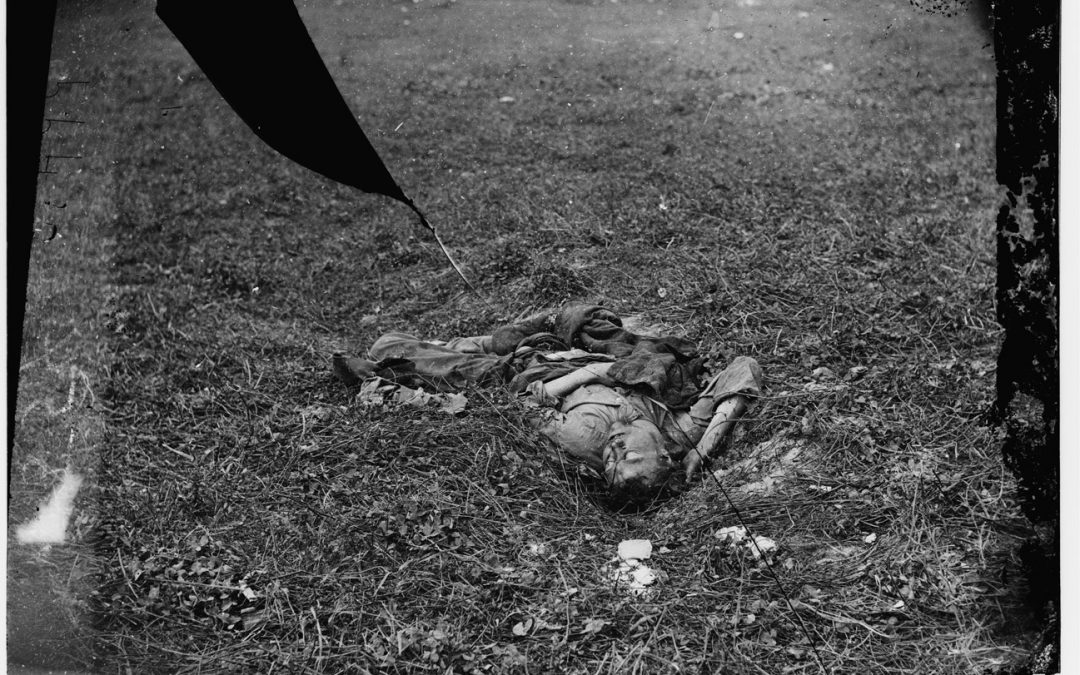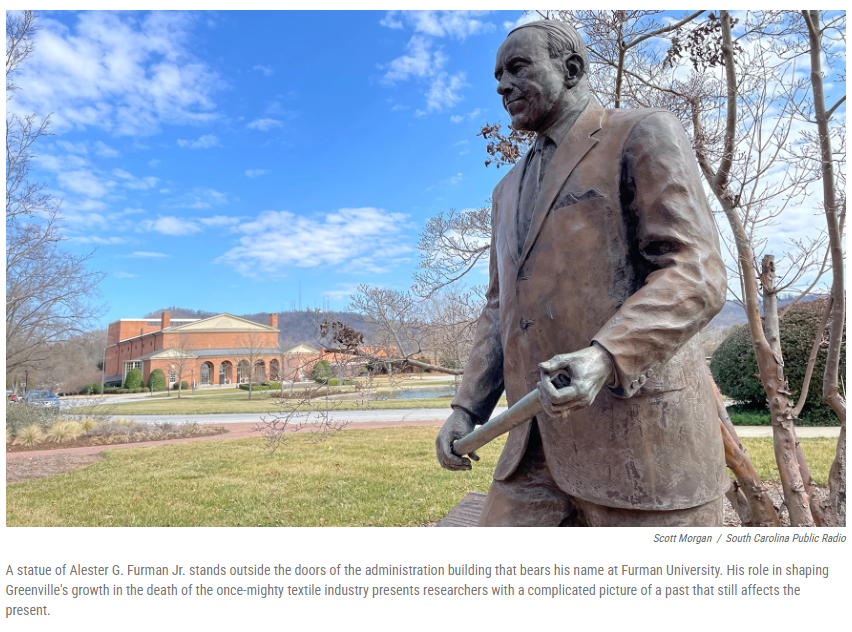In October 1862, a shocking and unique photo exhibition opened at Mathew B. Brady’s Broadway gallery in New York City.
A small placard at the door advertised “The Dead of Antietam,” and, as The New York Times reported on October 20, “crowds of people are constantly going up the stairs,” drawn by the “terrible fascination” of seeing gruesome photographs of bloated, dead bodies of soldiers as they fell in combat on the battlefield of Antietam during the Civil War.
The Battle of Antietam, fought on September 17, 1862, is the bloodiest day in American history. More than 22,700 Union and Confederate soldiers were killed, wounded, missing or captured in the battle, which was fought in the fields and woods outside the small, western Maryland town of Sharpsburg. It is also the first battle where American war dead were photographed. What for some had remained a distant, abstract war, was suddenly—and viscerally—brought to life. The reactions to the photographs reflected the intensity of their content.
“Mr. Brady has done something to bring home to us the terrible reality and earnestness of war,” the Times reported. “If he has not brought bodies and laid them in our dooryards and along the streets, he has done something very like it.”
Harper’s Weekly, the leading news weekly, devoted the center spread of its October 18, 1862, issue to images of the Antietam dead. Although the technology did not yet exist to reproduce actual photographs in newspapers and news weeklies, the periodical published woodcut engravings of eight photos, including six showing the dead.
Civil War Photo Breakthrough

Several dead Confederate artillery men lie outside Dunker Church after the Battle of Antietam. The church was the location of some of the bloodiest fighting during the battle.
Collection of Bob Zeller
Brady and his photographers, as well as others, followed the armies to capture scenes from the battlefronts. Together, they produced as many as 10,000 documentary images, or perhaps even more, from the camps, battlefield and home front. Some, such as “The Dead of Antietam,” brought the gruesome realities of warfare home to the American public.
From the start, photographers were eager to capture dramatic images of the war. At least two southern photographers took photographs of the damage wrought by the April 1861 bombardment of Fort Sumter in South Carolina, which started the conflict. Brady personally followed the Union Army into Virginia in July 1861 but had to flee back to Washington with no battlefield photos after the army was routed in the Battle of First Bull Run.
During the Peninsula Campaign in June 1862, Brady photographer James Gibson had photographed a remarkable scene of vast suffering—wounded Union soldiers scattered on the ground of a makeshift field hospital at Savage Station, Virginia. After the Battle of Cedar Mountain, Virginia, in August 1862, Brady photographer Timothy O’Sullivan captured an image of horses killed during the fighting.
But the Union Army of the Potomac kept losing battles early in the war. Until Antietam, Brady’s men had no opportunity to take their cameras onto a battlefield still littered with dead.
Alexander Gardner Photographs Two Days After Battle’s End

A ditch, called ‘Bloody Lane,’ with bodies of dead Confederate soldiers awaiting burial after the Battle of Antietam, photographed by Alexander Gardner, September 19, 1862.
History Archive/Universal Images Group/Getty Images
The photographer who captured “The Dead of Antietam” was Alexander Gardner, a burly Scottish immigrant with a round face and a long beard who managed Brady’s Washington gallery.
On September 19, 1862, two days after the battle, Confederate Gen. Robert E. Lee withdrew his army into Virginia, leaving the battlefield in Union hands. That afternoon, Gardner took his first images. They showed a sunken road, soon to be known as “Bloody Lane,” still partially packed with dead Confederates who fought there.
The next day, Gardner worked his way around the center part of the battlefield, taking photos as Union burial crews labored to inter the dead in long, shallow mass graves. The entire countryside reeked of death (Gardner would sometimes rearrange bodies to pair with a dramatic narrative of the photo).
Gardner took glass plate negatives that had to be created and developed on the spot while still wet. Considering the primitive technology, he took photos at a furious pace that day and may have run out of glass plates. The next morning, September 21, at 10 a.m., he was able to use the military telegraph to send brief news of his accomplishment to the Washington gallery as well as an urgent “soon as possible” request: “Send four by ten glass. Got 45 negatives of battle.”
Gardner used the four-by-ten-inch plates in his stereoscopic camera. All 20 photos of the dead of Antietam were taken in stereo. The negatives produced stereo views that offered a 3-D photographic viewing experience—the closest thing Civil War America had to video. “The mind feels its way into the very depths of the picture,” wrote the essayist Oliver Wendell Holmes, an enthusiastic collector of stereographs and co-inventor of the first practical hand-held viewer.
Photos Bore Witness to War’s Horrors
Back in Washington, Gardner and his staff made prints from the negatives and mounted them on stereo view cards and single-image “Album Gallery Cards.” Each image bore a label on the reverse with a title or caption as well as a number. Brady’s earliest Civil War photographs, including the Antietam images, are among history’s first numbered, collectible cards, arriving on the American scene decades before baseball cards.
Brady and others sent copies of their latest stereo views to Holmes because he wrote about photography in The Atlantic Monthly. But to Holmes, the stereo views of the Antietam dead were all too real. “Let him who wishes to know what war is look at this series of illustrations,” he wrote in the July 1863 issue.
Holmes’s son, the future Supreme Court Associate Justice Oliver Wendell Holmes Jr., had been shot through the neck and seriously wounded in the battle. Holmes immediately went to Maryland to search for his son and visited the battlefield on September 21 before eventually finding him in Harrisburg, Pennsylvania.
Gardner’s photos, wrote Holmes, “bore witness” to the “dread reality” of what he himself had seen: It was so nearly like visiting the battlefield to look over these views, that all the emotions excited by the actual sight of the stained and sordid scene, strewed with rags and wrecks, came back to us, and we buried them in the recesses of our cabinet as we would have buried the mutilated remains of the dead they too vividly represented.”
Civil War Photos Sold Well
Gardner and Brady knew they were capturing history with their cameras, but their primary reason for taking battlefield images was because they knew they would sell. And sell they did. Civil War photos and stereo views sold well during and after the war. Their popularity is evidenced by the dozens of original views available today at online auction sites or from antique photograph dealers.
Brady’s stereographs and Album Gallery Cards cost 50 cents each during the war. That’s $10.67 in 2020 dollars, putting them in the same general price range as a CD today. War views commanded a premium compared to scenic stereographs of, say, Niagara Falls or the Hudson River Valley, which sold for 25 cents each.
There is no evidence that the Antietam photos turned people against the war like television coverage of the Vietnam War help turn Americans against that conflict. Still, the photos shocked and fascinated and saddened those who saw them. And to this day, they reign as some of the most graphic images of American war casualties ever published.




